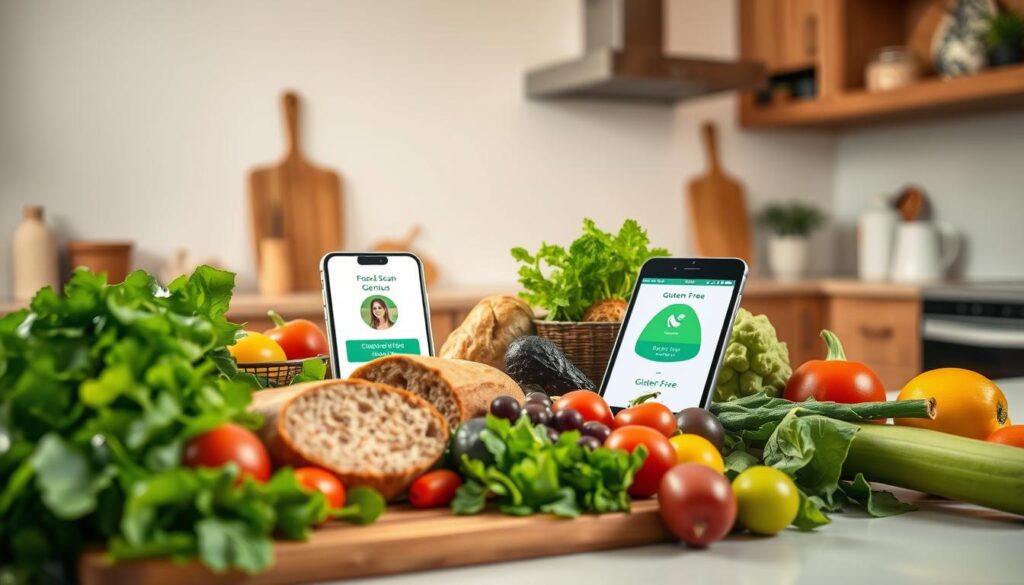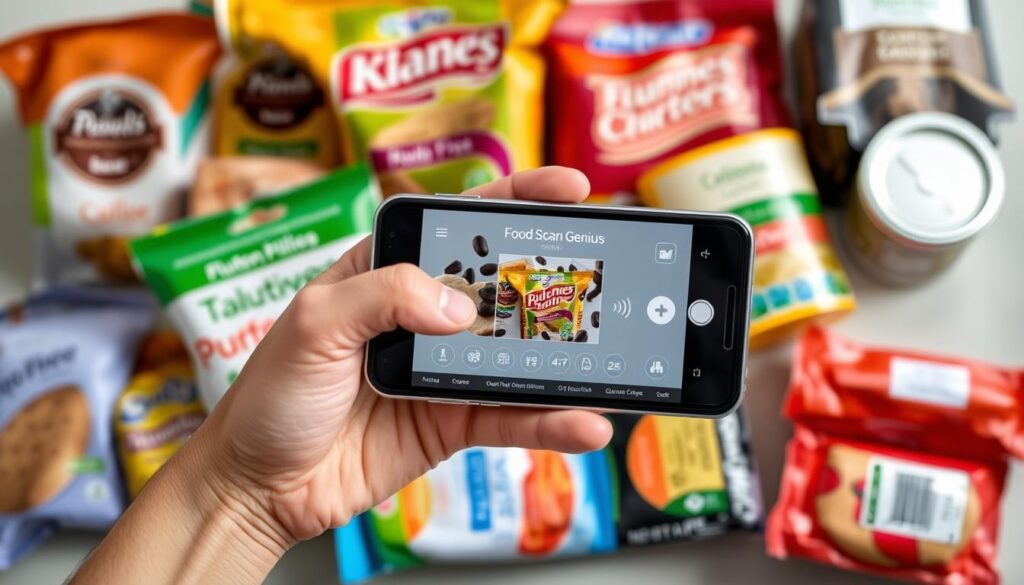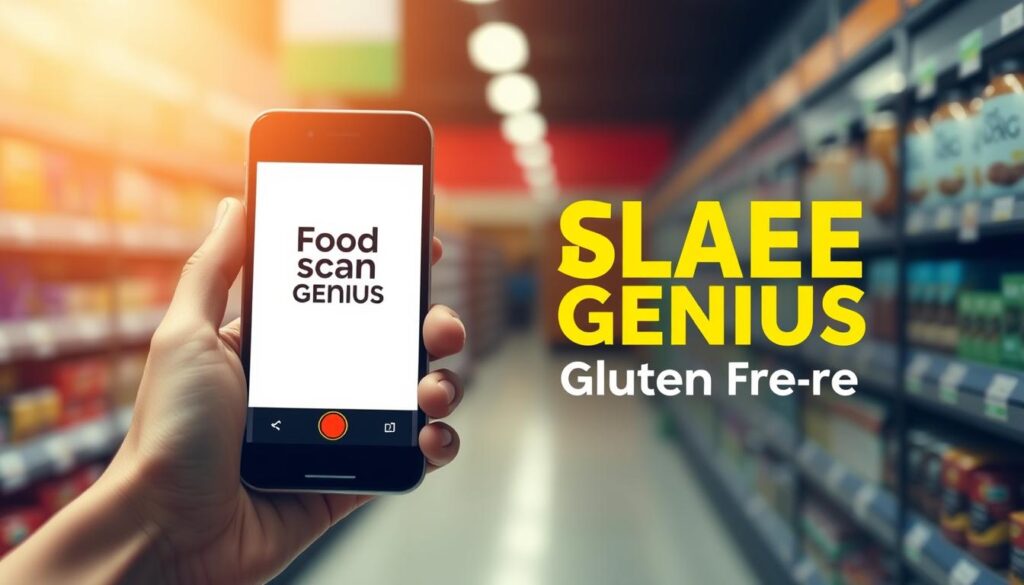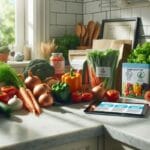Shopping for groceries can be tough for those with gluten sensitivities. Now, imagine scanning labels quickly and easily. The gluten-free scanner has changed the game for those on special diets1. It makes checking if foods are safe a breeze, making shopping easier1.
The need for gluten-free items has grown a lot. The market is expected to hit $8.3 billion by 20251. This rise is due to more people learning about gluten-related health issues. About 1% of the world’s population has coeliac disease1.
Food Scan Genius is a top-notch gluten-free scanner. It scans millions of products, acting like a personal nutrition detective in your pocket1. About 20% of people choose gluten-free diets for health reasons. This makes scanning tools even more important1.
Key Takeaways
- Gluten-free scanners simplify grocery shopping for those with dietary restrictions
- The gluten-free market is rapidly expanding
- Technology is making food safety more accessible
- Multiple reasons exist for choosing gluten-free diets
- Scanning apps provide instant product information
What is a Gluten-Free Scanner?
A gluten-free food scanner is a big help for people with gluten sensitivities. It turns smartphones into tools for checking food quickly. This makes choosing what to eat much easier.
Definition and Purpose
This digital tool scans food to see if it has gluten. It uses smart scanning to check ingredients fast. Its main goal is to make shopping and planning meals easier for those with gluten issues.
How It Works
These scanners use advanced tech:
- Barcode scanning technology2
- Artificial intelligence to analyze ingredients3
- Large databases of over 500,000 products2
Here’s how you use it:
- Open the app
- Scan the product’s barcode
- Get instant info on gluten
“Technology is changing how we manage diets, making it easier than ever.”
These scanners have cool features like lists of ingredients3 and updates from nutrition experts2. They even get high ratings from users2. They’re key for those who care about their health.
The Importance of a Gluten-Free Diet
Gluten-free diets are more than just a trend. For many, it’s a must for their health and happiness.

Gluten-free diets help manage health issues linked to gluten. Celiac disease affects 0.33% to 1.06% of kids and 0.18% to 1.2% of adults4. This shows how important it is to know about gluten-related health problems.
Health Benefits of Gluten-Free Living
- Reduces intestinal inflammation
- Improves nutrient absorption
- Alleviates digestive discomfort
- Supports overall gut health
Common Gluten-Related Disorders
Those with gluten disorders must stay away from gluten. Gluten is found in wheat, barley, and rye5. The main conditions include:
- Celiac Disease
- Non-Celiac Gluten Sensitivity
- Wheat Allergy
For some individuals, a gluten-free diet isn’t a choice—it’s a medical necessity.
People with gluten disorders often face nutritional challenges. About 20-38% of celiac patients have nutritional deficiencies4. Iron and vitamin B-12 deficiencies are common, affecting 12% to 69% and 8% to 41% of untreated patients, respectively4.
| Condition | Prevalence | Key Nutritional Concerns |
|---|---|---|
| Celiac Disease | 0.33% – 1.2% | Iron, B-12 Deficiency |
| Gluten Sensitivity | Varies | Nutrient Absorption Issues |
Managing a gluten-free diet requires careful planning and ongoing nutritional awareness. People need to work with healthcare experts to stay healthy and avoid gluten.
Features to Look for in a Gluten-Free Scanner
Finding gluten-free foods can be tough. But a good gluten-free scanner app can help a lot. We’ve found the key features that make a scanner great for those with dietary needs.
Accuracy of Scanning Technology
Choosing a gluten-free scanner means looking for accuracy. Top apps use AI and OCR to quickly spot gluten risks6. They can scan ingredients and give results in seconds6.
- Advanced scanning capabilities
- Real-time ingredient analysis
- Comprehensive product databases
User-Friendly Interface
A good app should be easy to use. Top apps have features that make managing your diet simple:
- Barcode scanning functionality
- Customizable dietary preferences
- Comprehensive product information
“Your gluten-free scanner should be as smart as it is simple to use!”
Additional Innovative Features
Top gluten-free scanners have more than just scanning. They include:
| Feature | Benefit |
|---|---|
| Ingredient Database | Over 850 tracked gluten-containing ingredients6 |
| Dietary Customization | Users can set up to 14 dietary preferences7 |
| Product Coverage | Access to products from 9 major supermarkets7 |
The right gluten-free scanner can change how you manage your diet. It gives you peace of mind and quick info on gluten risks right at your fingertips7.
: Coeliac UK Gluten Free Food Checker App Data8: Gluten-Free Mobile App Features6: Gluten Free For Me App Technology
Popular Gluten-Free Scanners on the Market
Finding gluten-free foods is now easier with new apps and devices. We’ve looked at the best tools for safe and informed food choices.

Mobile Apps for Gluten-Free Scanning
The market for gluten-free scanner apps has grown a lot. Here are some top picks:
- The Find Me Gluten Free app has over 70,000 restaurants with gluten-free options9
- The Gluten-Free Scanner app has a huge database of 500,000 food products and ingredients9
- More gluten-free foods are now on supermarket shelves than before10
Top-Rated Gluten-Free Apps
Here’s a quick look at how popular gluten-free apps rate:
| App Name | App Store Rating | Google Play Rating |
|---|---|---|
| Find Me Gluten Free | 4.8 | 4.6 |
| Gluten-Free Scanner | 4.7 | 4.8 |
| OpenTable | 4.9 | 4.7 |
Smart Kitchen Scanning Devices
Handheld gluten-free scanners are a big deal for advanced tech. The Nima gluten sensor is a standout, but remember, it costs money for the capsules9.
“Technology is making gluten-free living more accessible than ever!” – Gluten-Free Community
About 1% of the world’s population has gluten intolerance. These scanning tools are more important than ever9. Whether you use an app or a device, you have powerful tools to manage your diet.
How to Use a Gluten-Free Scanner
Finding gluten-free foods can be hard, but a gluten-free scanner helps a lot. These tools turn your phone into a great helper for a gluten-free diet.
Getting Started with Your Scanner
- Download a reliable gluten-free scanner app from your app store
- Enable camera and location permissions
- Create an optional user profile
- Learn the app’s basic scanning interface
Scanning Techniques and Tips
Being precise is important when scanning with a gluten-free food scanner. The app can check millions of products1, helping you choose what to eat easily.
- Ensure good lighting when scanning barcodes
- Hold your phone steady and close to the product
- Check multiple sources if results seem uncertain
Many apps have extra features like dietary filters for allergens like lactose and eggs11.
Pro Tips for Effective Scanning
| Tip | Description |
|---|---|
| Check Compatibility | Ensure your device meets app requirements (Android 8+, iOS 13+)11 |
| Regular Updates | Keep your gluten-free food scanner app current for most accurate information |
| Cross-Reference | Compare scanner results with physical label reading |
Remember, a gluten-free food scanner is your digital companion in maintaining a safe and healthy diet!
Follow these tips to become a scanning pro. You’ll find managing a gluten-free lifestyle easy and fun1.
Understanding Gluten Labels
Exploring gluten-free products can be like solving a puzzle. Labels are key to finding safe ingredients and keeping you healthy12. It’s vital for those with gluten sensitivities or celiac disease13.
Decoding Food Labels: What to Look For
When checking food labels, look for these important signs:
- Certified gluten-free symbols
- Explicit warnings about wheat content
- Detailed ingredient lists
Common Gluten Ingredients to Avoid
Gluten can sneak into many foods. Be careful of these ingredients:
- Wheat
- Barley
- Rye
- Malt
- Brewer’s yeast
Know your labels, protect your health” – Gluten-Free Living Experts
The gluten-free market is growing fast, with about 30% of people looking for gluten-free products12. But, not all gluten-free products are safe. Around 33% don’t meet the less than 20 parts per million (ppm) standard12.
Pro tip: Always check labels again, even if you’ve bought something before. Ingredients can change without warning.
FDA Labeling Regulations
The FDA has clear rules for gluten-free labels. A product can be labeled gluten-free if it has less than 20 ppm of gluten13. Wheat must be listed on labels, but rye and barley don’t always need to be13.
Shopping for gluten-free items can be easier with scanning apps. These apps are popular, with over 1 million downloads together12.
The Role of Technology in Gluten-Free Living
Technology is changing the gluten-free lifestyle for the better. AI and machine learning are making it easier to manage gluten-free diets. Now, there are hundreds of gluten-free apps that offer a lot of nutritional information and support14.
Food Scan Genius is a leading example of gluten-free technology. It uses advanced AI to give users quick insights into food ingredients and allergens. This can change healthcare, retail, and food tech forever15.
The future of gluten-free living is bright. Scanning tech is getting better, helping people make quick, smart food choices. Apps like GlutenFreeTravelSite and Find Me Gluten Free are getting more useful, helping those who follow a gluten-free diet14.
As tech keeps improving, we’ll see even more tailored solutions. From AI food scanners to detailed diet management tools, the gluten-free world is in for a big upgrade. This means more convenience, safety, and peace of mind for everyone.
FAQ
What exactly is a gluten-free scanner?
A gluten-free scanner is a smart app or device. It uses AI to scan barcodes and check if products have gluten. It’s like a food detective in your pocket, helping those with gluten issues make safe choices quickly.
How accurate are gluten-free scanning apps?
Gluten-free scanning apps are usually very accurate, about 90-95%. They use big databases and AI to check ingredients for gluten. But, always double-check labels and talk to health experts too.
Are gluten-free scanners free to use?
Yes, many apps offer both free and paid versions. The free ones usually scan products, while paid versions add more features like nutrition tracking and personalized advice.
Can these scanners detect hidden gluten sources?
Yes! These scanners find gluten not just in obvious ingredients but also in hidden sources like modified food starch. They help spot risky products that might not seem gluten-heavy at first.
Do gluten-free scanners work internationally?
Most good apps have international databases, but coverage varies. It’s best to check the app’s coverage before using it in different places.
Are these scanners helpful for people with different levels of gluten sensitivity?
Absolutely! These scanners help everyone, from those with celiac disease to those who just prefer gluten-free. They give detailed info on ingredients, helping users make the right food choices.
Can I use gluten-free scanners offline?
Some apps let you scan offline, but features might be limited. It’s best to have internet when you can for full access.
How often are the product databases updated?
Good apps update their databases weekly or monthly. This keeps users informed about new products and ingredient changes.
Source Links
- Gluten Free Scanner – Apps on Google Play
- The Gluten Free Scanner – Apps on Google Play
- The Gluten Free Scanner
- The Gluten-Free Diet: Safety and Nutritional Quality
- The gluten free diet – All you need to know about the diet that will make you well again
- Gluten Free For Me – Apps on Google Play
- How to get the most from the Gluten Free Food Checker app
- Apps for Gluten-Free Eating
- 7 Best Gluten-Free Apps to Make Your Life Easier in 2025
- These Gluten-Free Apps Will Help You Live Your Best Gluten-Free Life
- Live Well Gluten Free app
- Decoding Food Labels: A Comprehensive Guide for Gluten-Free Living – Goodies Gluten Free Bakery
- Tech Savvy with Gluten-Free Technology!
- These 3 Tests Can Tell You Whether Your Food Is Really Gluten-Free





